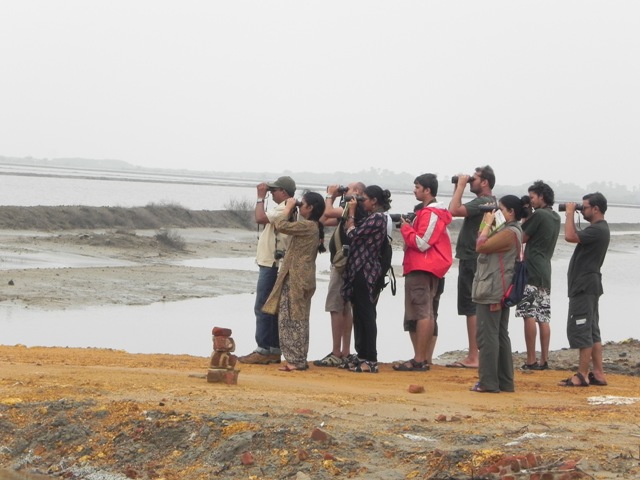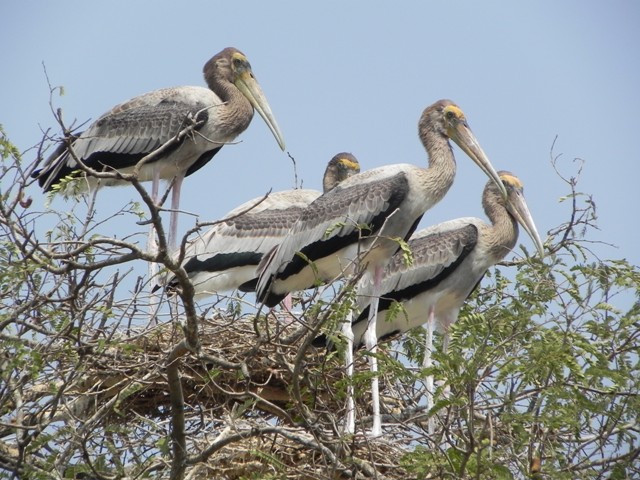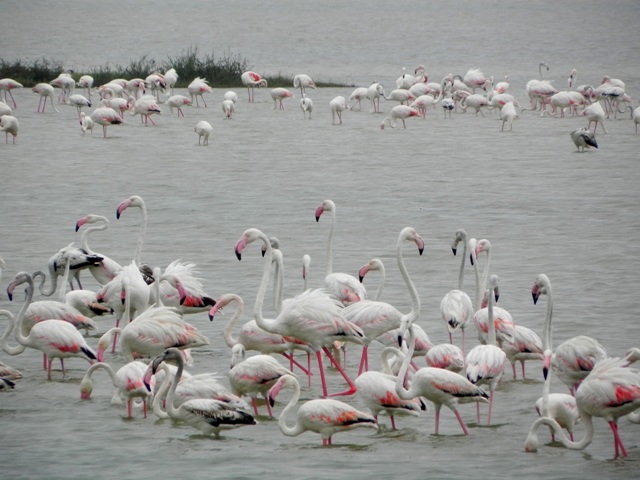NAGAPATTINUM - A BIRD PARADISE
Introduction
When I first saw a migratory bird in Visakhapatnam near the airport, the excitement grew and I was inquisitive to have a closer look. The world of bird migration is fascinating. And reading about what our ancestors did to understand the sudden absence
and sudden presence of the birds is even more intriguing.
Point Calimere-or Nagapattinum is one such place in Tamil Naidu which is a meeting place for many types of migratory water birds in India. In October, these water birds or pelagic birds arrive from the Rann of Kutch, Eastern Siberia, Northern Russia,
Central Asia and parts of Europe for their breeding season and begin their journey back in January.
Far from the concrete jungles, honking, regular hustle-bustle, polluted air, and boredom of city life style we planned to make a visit to the hub of migratory birds i.e. Point Calimere Wildlife and Bird Sanctuary in Nagapattinam district in Southern
India.
Journey
What could be more exciting than travelling in your car all the way to your destination,Point Calimere. The most important of all the decision was to take my beloved wife Shakti Bishnoi, who was 7 months pregnant. She agreed to be part of the trip.
We both are ornithologists and wildlife photographers.
The journey commenced early morning driving through the Eastern Ghats. Followed by the fascinating stretches of paddy fields, villages, some vibrantly active and some serene amidst tranquility of nature. We were crossing the then Andhra Pradesh. We
reached our destination after 3 days with halts at Rajamundry, Chennai, Pondicherry and straight to Bombay Natural History Society Centre for Migratory Birds study, Pt. Calimere (Vedaranyam) . We start at dawn and stop at dusk making our journey more
fulfilling and not tiring.
Nagapattinum-Point Calimere
Point Calimere
The Point Calimere sanctuary is situated in Nagapattinum District of Tamil Naidu and is the only Ramsar site in the state, owing to its status of wetland of global importance. The habitat of sanctuary is a unique mix of grasslands,
mudflats, backwaters, sand dunes and tropical dry evergreen forests. It has also salt pans spread across huge area. It is unique in attracting and harboring a large variety of birds, for feeding and breeding purpose not only local resident birds but also
migratory birds. Gaining knowledge and developing awareness about wildlife particularly colourful birds is not only entertaining but also helps in motivating people towards conservation.
We reached late in the night, after braving the storm Neelam which just touched the BNHS study centre amidst heavy rainfall. We were tired and slept like dead. Next day we were fresh and ate steamy South Indian tiffin and then proceeded to see Point
Calimere Wildlife sanctuary with due permission from Forest officials. We saw a herd of deer and jungle birds enroute our journey. .
The weather was clear and our team leader Dr Balachandran Renowed Ornithologists and scientist took us towards wilderness looking for migrants in the vicinity. We were ever vigilant not to miss out on any bird species. The birds in the Point Calimere
include threatened species such as Spot Billed Pelican, Nordmann’s Greenshank, Spoon-Bill Sandipiper and Black Necked Stork. Near threatened species include Black Headed Ibis, Asian Dowitcher, lesser Flamingo, Darter etc. we were educated on birds and their
habitat by our ever smiling guru, Dr Balachandran. He is a living encyclopedia on birds. We were fortunate to be in his presence. We were walking in mud, in water, in rain joyously. Everyone present there could not complain as Dr Balachandran was leading
us everywhere.

birdwatching enthusiasts
Bird Ringing
Third day onwards, we started observing the ringing phenomena carried out by Dr Balachandran, who has been doing this for past three decades. Noted ornithologist and working with BNHS since 1980s. We could capture migratory birds i.e Black tailed Godwit,
Common Redshank, Common Greenshank etc and resident birds viz, Indian Pitta, Common tailor bird, Asian paradise flycatcher and saw Ringing/banding. Captured birds are fitted with BNHS metals rings and biometric of birds are recorded. Ringing help to study
their population, their lifespan, the breeding origin, migratory routes and stopover sites of select long distance migratory birds. The migration data collected for birds is interesting and educating. As part of birds ringing we learned bird trapping using
mist net, clap trap and also how to remove birds from mist nets while holding them without injuring them. All birds have different kinds of bands/rings depending upon their tarsus bone and accordingly we use to select the band to fix while holding them safely.
We were also taught about sexing and ageing by looking at the morphological features or by examining the cloacae. Most important of all, we learned molting and taking morph metric measurements viz wing, bill, tarsus and tail using measuring devices and then
making data entry in a sheet for records. Birds after ringing were released at the place of capture but not in front of predators like Brahminy kite/Black kite etc. The BNHS has captured, ringed and released over, 2,00,000,birds during the course of several
years and is still continuing. The serious problem faced by migratory birds is that of poaching and hunting on their stop- overs. For example, the population of Siberian Cranes declined due to hunting when they cross Afghanistan and Central Asia.

Storks
At the Beach
In the evening as the clouds were swaying away, the sky became clear and we marched toward quaint beach. It was fun to see Heuglin’s Gull, Brown Headed Gull, Caspian tern, Lesser Crested Tern, Large Crested Tern, Whiskered Tern and many other pelagic
birds. We were glued to our binoculars for at least one hour. And Dr Balachandran constantly guiding us and helping us to identify them, as during their flight they didn’t stop. So we were attentive enough to capture the image in mind and refer the Field
guide for understanding. “A field guide to the birds of Pt Calimere” by Dr Balachandran is an excellent hand book .
In the evening, we all had fun to witness Terns catching fishes. We came back contented and had nice dinner prepared by the dedicated staff of BNHS. We had wonderful discussion post dinner and also elaborate discussion on various current topics related
to birds conservations and various initiative undertaken by BNHS. Entire course got benefitted as participants were from various field of expertise and they shared their experiences to update each other. With heavy heart we all started departing towards our
destination post successful completion of course early morning. Some preferred to stay one more day. And why not, given an opportunity a avian lover would definitely prefer to stay more as the place itself is so enthralling and enchanting and above all it
is a Birds Paradise.
Pt Calimere is one of the mandatory tour for qualifying Basic Ornithology course conducted by BNHS. The course covers all the aspects concerned with Birds viz. external and internal features, behavioural ecology, birds behavior, breeding, migration,
birds classification etc.
Concern
Point Calimere, the traditional and famous wintering ground of waders and other waterfowl, has certainly undergone tremendous changes, which is evident from the salt water intrusion. The increase in salt content is primarily caused by extensive salt works,
both edible and industrial salts, excessive pumping of groundwater by villagers, heavy/significant decline in annual rainfall; blocking of feeding channels to the swamp by extensive bunds raised for salt works. The degradation in soil quality is indicated
by changes in traditional livelihood practices—rain fed agriculture replaced by salt works and fishing. This has affected the microhabitat diversity and therefore the bird population.

flamingos
The Lessons
We are at a location geographically where we are given opportunity and responsibility to host such beautiful species. As host we must ensure their safety and security with regard to the food and shelter we provide. We must keep the area clean for their
better health. Mother earth is mother to all of us, even the smallest living being is precious to her. Humans should not dominate the mother earth and exploit it for personal gains, rather learn to co-exist nicely. Birds contribute to the beauty of the natural
world in their own incomparable way. They command our instant attention whether seen close by or soaring high up in the air radiating their joy of inner and outer well-being. A world without birds is unthinkable, yet most of us take them for granted and pay
scarce attention to their valuable ecological role as saviors of other life forms on earth. The statement “If birds die, we die” sums up this ecological truth with utmost brevity. It is therefore the paramount duty of everyone interested in birds to save them
and their habitat, not only for their good but for the good of our own selves and of generations to come.
On completion of course we headed towards Chennai had one day halt near Gundy National Park(IIT Madras). Next day with heavy heart we started our return journey, en-route halt at Pulicat lake that is also one of the stop over site for migratory birds.
We spotted good numbers of Flamingoes. Later my wife took over the command of the car and gave me opportunity to explore the tempting scenery post Neelam Toophan. It was an incredible and unforgettable experience watching the gathering of avian world at Pt
Calimere. .
( Mrs Shakti Bishnoi
& Mr A S Bishnoi)